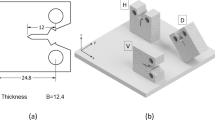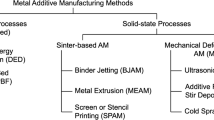Abstract
A new type of magnesium alloy extrusion-shear (short for ES) composite extrusion technology which combines the characteristics of direct extrusion and two pass equal channel extrusion has been put forward. The experiments of ES process and direct extrusion have been performed, and direct extrusion and ES dies suitable for industrial horizontal extruder have been designed and manufactured. Three-dimensional thermomechanical finite element models and conditions of the ES process and direct extrusion have been established. Extrusion forces and accumulated strains and stresses and temperatures evolution of the ES process have been obtained. The loads of the ES process increase obviously compared with those of direct extrusion. Maximum temperatures during the ES process are higher than those of direct extrusion. The computer simulation analyses of stress state for the billets reveal that part of the billet is exerted in four directions of compressive stress. The ES process could cause cumulative strains and shear stress in magnesium alloy billets than direct extrusion. Therefore, more grain refinements could be achieved. Based on the microstructure observations of center positions for the ES process and direct extrusion rods, grains have been effectively refined with extrusion temperature. It is found that there are many similarities between finite element simulation results and experimental results.
Similar content being viewed by others
References
Segal VM et al (1981) Plastic working of metals by simple shear. Russ Metall 1:99–105
Zhernakov VS, Stol Yarov VV et al (2001) The developing of nanostructured SPD Ti for structural use. J Scr Mater 44(8-9):1771–1774
Gong X, Li H, Kang SB, Cho JH, Li S (2010) Microstructure and mechanical properties of twin-roll cast Mg-4.5Al-1.0Zn alloy sheets processed by differential speed rolling. Mater Des 31(3):1581–1587
Gong X, Kang SB, Li S, Cho JH (2009) Enhanced plasticity of twin-roll cast ZK60 magnesium alloy through differential speed rolling. Mater Des 30(9):3345–3350
Hu HJ, Huang WJ (2013) Effects of turning speed on high-speed turning by ultrafine-grained ceramic tool based on 3D finite element method and experiments. Int J Adv Manuf Technol 67(1–4):907–915
Hongjun H, Dingfei Z, JunPing Z (2010) Microstructures in an AZ31 magnesium alloy rod fabricated by a new SPD process based on physical simulator. Trans Nonferrous Met Soc China 3:478–483
Hongjun H, Dingfei Z, MingBo Y, Ming D (2011) Grain refinement in AZ31 Magnesium alloy rod fabricated by an ES SPD process. Trans Nonferrous Metals Soc China 21(2):243–249
Hongjun HU, Zhang D, Fusheng PAN, Mingbo YANG (2009) Analysis of the cracks formation on surface of extruded magnesium rod based on numerical modeling and experimental verification. Acta Metall Sin (Engl) 22(5):353–364
Hongjun HU, Dingfei ZHANG, Fusheng PAN (2009) Computer simulation and optimization of equal channel angular extrusion of AZ31 magnesium alloy. Mater Sci Forum 610–613:780–782
Hu HJ, Huang WJ (2013) Studies on wears of ultrafine-grained ceramic tool and common ceramic tool during hard turning using Archard wear model. Int J Adv Manuf Technol 69(1–4):31–39
Hadadzadeh A, Wells MA, Jayakrishnan V (2014) Development of a mathematical model to study the feasibility of creating a clad AZ31 magnesium sheet via twin roll casting. Int J Adv Manuf Technol. doi:10.1007/s00170-014-5831-6
Mofid MA, Abdollah-zadeh A, Hakan Gür C (2014) Investigating the formation of intermetallic compounds during friction stir welding of magnesium alloy to aluminum alloy in air and under liquid nitrogen. Int J Adv Manuf Technol 71(5–8):1493–1499
Feng F, Huang S, Jianhua H, Meng Z, Lei Y (2013) Analysis of the bulging process of an AZ31B magnesium alloy sheet with a uniform pressure coil. Int J Adv Manuf Technol 69(5–8):1537–1545
Rajakumar S, Razalrose A, Balasubramanian V (2013) Friction stir welding of AZ61A magnesium alloy. Int J Adv Manuf Technol 68(1–4):277–292
Wu G, Hu H, Gong X, Zhang W, Wang K, Dong T (2007) Application and development of casting process parameterized graph library based on AutoCAD software. Foundry Technol 28(4):535–537
Chung YH, Park JW, Lee KH (2006) An analysis of accumulated deformation in the equal channel angular rolling (ECAR) process. Mater Inter 12(4):289–293
Hu H, Yang M, Gong X, Li G (2006) Optimization of casting processes based on computer numerical simulation. Ordnance Mater Sci Eng 29(6):51–53
Author information
Authors and Affiliations
Corresponding author
Rights and permissions
About this article
Cite this article
Hu, HJ., Wang, H., Zhai, ZY. et al. The influences of shear deformation on the evolutions of the extrusion shear for magnesium alloy. Int J Adv Manuf Technol 74, 423–432 (2014). https://doi.org/10.1007/s00170-014-5999-9
Received:
Accepted:
Published:
Issue Date:
DOI: https://doi.org/10.1007/s00170-014-5999-9




